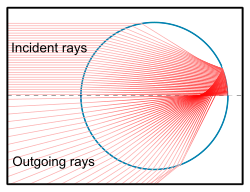Light scattering by particles
Light scattering by particles is the process by which small particles (e.g.
.Maxwell's equations are the basis of theoretical and computational methods describing light scattering, but since exact solutions to Maxwell's equations are only known for selected particle geometries (such as spherical), light scattering by particles is a branch of computational electromagnetics dealing with electromagnetic radiation scattering and absorption by particles.
In case of
The relative size of a scattering particle is defined by its size parameter x, which is the ratio of its characteristic dimension to its wavelength:
Exact computational methods
Finite-difference time-domain method
The FDTD method belongs in the general class of grid-based differential time-domain numerical modeling methods. The time-dependent Maxwell's equations (in partial differential form) are discretized using central-difference approximations to the space and time partial derivatives. The resulting finite-difference equations are solved in either software or hardware in a leapfrog manner: the electric field vector components in a volume of space are solved at a given instant in time; then the magnetic field vector components in the same spatial volume are solved at the next instant in time; and the process is repeated over and over again until the desired transient or steady-state electromagnetic field behavior is fully evolved.
T-matrix
The technique is also known as null field method and extended boundary technique method (EBCM). Matrix elements are obtained by matching boundary conditions for solutions of Maxwell equations. The incident, transmitted, and scattered field are expanded into spherical vector wave functions.
Computational approximations
Mie approximation
Scattering from any spherical particles with arbitrary size parameter is explained by the
For more complex shapes such as coated spheres, multispheres, spheroids, and infinite cylinders there are extensions which express the solution in terms of infinite series. There are codes available to study light scattering in Mie approximation for spheres, layered spheres, and multiple spheres and cylinders.
Discrete dipole approximation
There are several techniques for computing scattering of radiation by particles of arbitrary shape. The discrete dipole approximation is an approximation of the continuum target by a finite array of polarizable points. The points acquire dipole moments in response to the local electric field. The dipoles of these points interact with one another via their electric fields. There are
Approximate methods
| Approximation | Refractive index | Size parameter | Phase shift |
|---|---|---|---|
| Rayleigh scattering | abs(mx) very small | very small | |
Geometric optics |
very large | very large | |
Anomalous Diffraction Theory |
abs(m-1) very small | x large | |
| Complex Angular Momentum | moderate m | large x |
Rayleigh scattering
Rayleigh scattering regime is the scattering of light, or other electromagnetic radiation, by particles much smaller than the wavelength of the light. Rayleigh scattering can be defined as scattering in small size parameter regime .

Geometric optics (ray-tracing)
See also
- Codes for electromagnetic scattering by spheres
- Codes for electromagnetic scattering by cylinders
- Discrete dipole approximation codes
- Finite-difference time-domain method
- Scattering
References
- Barber,P.W. and S.C. Hill, Light scattering by particles : computational methods, Singapore ; Teaneck, N.J., World Scientific, c1990, 261 p.+ 2 computer disks (3½ in.), ISBN 9971-5-0832-X(pbk.)
- Bohren, Craig F. and Donald R. Huffman, Title Absorption and scattering of light by small particles, New York : Wiley, 1998, 530 p., ISBN 978-0-471-29340-8
- Hulst, H. C. van de, Light scattering by small particles, New York, Dover Publications, 1981, 470 p., ISBN 0-486-64228-3.
- Kerker, Milton, The scattering of light, and other electromagnetic radiation, New York, Academic Press, 1969, 666 p.
- Mishchenko, Michael I., Joop W. Hovenier, Larry D. Travis, Light scattering by nonspherical particles: theory, measurements, and applications, San Diego : Academic Press, 2000, 690 p., ISBN 0-12-498660-9.
- Stratton, Julius Adams, Electromagnetic theory, New York, London, McGraw-Hill book company, inc., 1941. 615 p.


